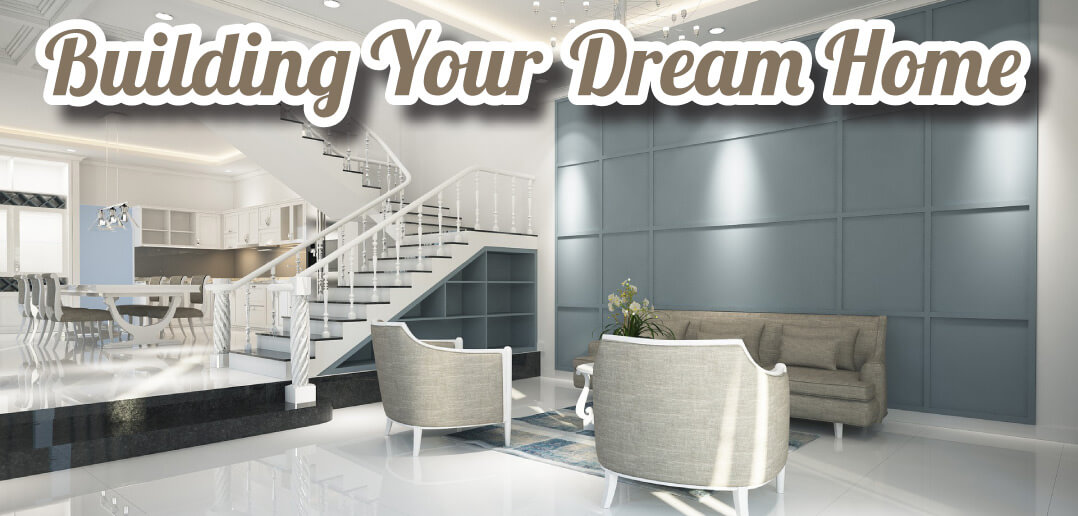Building Your Dream Home in Lincoln, NE – 2018
When it comes time to consider a new home, the first of many decisions ahead is whether to build or to buy. If it’s not immediately clear which one is the best option for you, looking into both isn’t a bad idea at all. There are generally pros and cons either way you go, as with any fork in the road that you’ll encounter in life. Specifically with respect to building a home, at the top of the list of pros is the ability to design your home to be exactly what you want it to be, with control over every single aspect from floor plan to finishes. Higher energy efficiency and lower repair costs are attractive benefits as well, and the list goes on from there.
Financing Options
If you’ve made the decision to build, the next step is getting your financing in place as it will determine your budget. If you’re thinking “construction loan” sounds scary, rest assured it’s really not at all; it’s actually quite similar to obtaining financing in order to buy an existing home on the market. The initial steps are the same with respect to both, in the following order:
- Meet with your lender to get pre-approved for the amount you can afford.
- Develop your wish list and preferences, including location(s) and features.
- Tour new developments and visit with builders and/or the real estate agents representing them in your price range and preferred location(s).
“There are several essentials to keep top of mind when building a home, the first of which being getting pre-qualified for your long-term financing before you start the construction process,” advises Tyler Rains with Union Bank & Trust. “This will assure you that you are building a home you can afford while not selling yourself short.
Along with that step, at the start of the process, I always suggest meeting with several builders. You will find that all builders operate in different ways, have access to different build sites, and ultimately offer different products. It’s important to be firm with what you want for your new home so be sure the builder you choose can meet those expectations. If your builder is willing, review the budget with them. Building a home is expensive and it’s good to know what you are getting into beforehand.
When you’ve selected your builder, always sign a contract with them. It’s just good business practice. You’ll then want to review the timelines established by your builder once the project begins. By staying on top of the timelines, you will know when it’s time to list and sell your existing home. You will also know when it’s appropriate to start the refinance process of your construction loan to your long-term fixed rate mortgage.
In today’s housing market there are several benefits to building a new home rather than purchasing an existing one. When you build a home you are able to choose the location and builder as well as customize your home from the ground up. Take your time with this process. This is one of the biggest investments you will make in your life! On the other hand, do be aware that one of the major challenges of building a home is the personal time commitment involved. Visiting the site regularly, meeting with your builder, picking out paint colors, choosing floor coverings and deciding on all the finishing touches takes time. Although the final product is very rewarding for most, the time commitment can be overwhelming for some individuals.
You should take the time to think through every aspect of the process and, although this isn’t fun, think through the worst-case scenarios. Even then, be prepared for the unexpected. In almost every build, there are changes that come about, with some that are expected and some that aren’t. Costs can vary from 5%-10% or more. When this happens, it’s important to make sure funds are available to cover the changes.”
In agreement, Jordan Moehlenhoff with West Gate Bank further emphasizes, “Always be prepared for a scenario when you go over budget, because it happens often. Another thing to be careful about is jeopardizing your financing during the building process. Make sure there are no drastic changes to your financial landscape that would affect eligibility during that time, just as you would with a home loan to purchase one on the market. Don’t quit your job, don’t open a new line of credit, and don’t make new large purchases without talking to your loan originator. Whoever you work with on the financing end should be there to coach you throughout the process. Get pre-qualified, finalize the details, and then know your budget and what that gets you.
In addition to going over budget, a potential drawback could be finding a lot. As far as the benefits, as previously mentioned it’s largely the customization of every aspect and control of the budget. If you are looking in the $300,000+ price range, many people feel that they can build a house that is ‘to their liking’ in relation to the current inventory. Also, consider how long you are going to live in this house; the longer the time frame, the more it makes sense to build.
It’s also important to note that the cost of construction material has been rising steadily in the last couple of years. Interest rates are expected to be trending upward in the next 12-18 months as well. West Gate Bank offers an extended rate lock program that allows a person building their dream house the ability to secure an interest rate up to 9 months in advance of completion.”
Once you get past the initial three steps outlined previously and discussed more in depth by the lenders, the next ones you’ll take with respect to financing will be dependent upon whether you have opted for a production model or a custom home. The term production home refers to when builders construct multiple houses within a specific development, while custom home means building on your own lot with your own unique design. With the latter, there will be more financing options to consider as well as more steps involved, including arranging for a construction loan.
If you’re buying within a development, you may opt to work with your preferred lender or the builder oftentimes can help arrange financing for you. This process will go much like buying an existing home, with the exception being you’ll apply for your loan when you sign the contract with the builder, but the loan terms won’t be locked in until the home build is complete.
For a custom home, construction loans aren’t as widely available, so you’ll likely have to shop around. There are generally one or two steps involved. First, you could obtain a loan that’s interest-only during the building process, then converts into a mortgage once construction is complete. Alternatively, you could take out an interest-only loan for construction, then refinance into a regular mortgage upon completion. Since construction loans are considered to be higher risk, you’ll need a very good credit and a larger sum of money for a down payment.
If you do already own the land, you can use it as equity for your construction loan. Then there’s the possibility of your lender offering a bridge loan if you have equity in your current home. The risk with that lies in the contingency of selling your current home. You may also consider selling your current home and renting temporarily while waiting for the new one to get built. Moving twice isn’t ideal of course, but it does allow the equity in your current home to be used toward your new home.
In conclusion, Matt Gutschenritter with Cornhusker Bank circles back to reiterate that the process of obtaining financing to build a new home is generally not much different than the process of obtaining financing for an existing home. “Basically, at the end of the construction, all parties involved, including the borrower, the builder, the realtor, the bank, etc. will want to have the peace of mind that the new owners have their long-term financing in place and ready to go. The process starts with getting pre-approved for their long term financing. Once we have that in place, it’s a matter of having the discussion with the builder to determine who will be taking out the financing for the new construction, and putting together a contract. If the builder takes out the construction loan, then we work with the buyer in getting them approved for a purchase transaction once the house is completed. If the buyer/borrower takes out the construction loan, we work with them during the construction process, and get them prepared to have their long-term financing set up as soon as their house is built. Upon completion of the construction, we would set up their long-term financing and pay off their construction loan.”
Gutschenritter also offers a few things to consider when weighing the pros and cons, noting, “There are benefits to both building a new home as well as buying an established one. The most obvious advantage to building is that you are assured to get the features and floor plan that you want. However, when it comes to building, you may not be able to build in a neighborhood that is close to the area of town that you want to be in based on location near schools, work, shopping, friends and family, etc. As far as costs go, it can be more expensive to build than to buy, but not always. The initial costs to get into a new construction may be higher, but chances are there should be minimal expenses when it comes to repairs, decorating, and general upkeep. With an existing home there could easily be the need for replacing the roof, windows, flooring, equipment, appliances, etc. With a newly built home, everything is built to current code, and therefore should be less expensive to heat and cool. Most people do not realize that Homeowners Insurance is typically less expensive on a newly built home as well.”
Finally, he explains, “Although construction loan rates will vary from one lender to another, usually the difference is minimal. Always keep in mind that the typical construction loan process is approximately 6 months long and during this period the customer only pays interest on the balance that has been drawn upon. Do not get overburdened with the construction loan itself. The bigger financial impact will come with the long-term financing. Look for a lender that has your best interests at hand for the long term.
Mortgage rates continue to be at or near record lows. It seems most of the talk around the industry is that the Fed may soon be increasing the Federal Prime Interest rate. That is not directly linked to long-term mortgage-type rates; however, it will usually coincide with mortgage rates increasing at some point in the near future.
As far as resources go, usually we take out an interest rate “lock” around 60 days prior to the completion of a newly constructed home. However, with the threat of rates going higher in the near future, if someone is losing sleep over these interest rates, at Cornhusker Bank we offer a 6 month “lock” program to help eliminate this issue.
We have a lot of useful information you can check out on our website, www.cornhuskerbank.com, where, amongst other features, a customer can complete a mortgage loan application or pre-qualification online. The ability to do that has worked well for many customers and their busy schedules. It is streamlined and therefore eliminates a lot of the questions, based on the answers given, that the regular paper application presents.”
Builder Selection
Aside from the different types of financing and working within your budget among the other things that were just discussed, there are other matters of importance to consider when evaluating builders and then determining which is the best fit for your project. Body of work definitely speaks for itself, as do references – check out both.
“When building new it’s important to select a reputable builder with a proven track record,” says Bo Jones with Tru-Built Construction, who is also currently serving as president of the Home Builders Association of Lincoln (HBAL). “What you get with that is a quality home and a builder warranty which covers the structure and systems for at least a year, and oftentimes longer, on items such as the roof, windows, siding, and mechanical systems. With a new home you can figure 15+ years without having to look at any major repairs, whereas an existing home you might have a list to tackle every year. HBAL is a great resource for finding leaders in the Lincoln market for any home project.
Because new home construction is oftentimes the largest investment people will make in their lifetime, it’s important to build with someone who has a well-documented track record of consistently delivering a quality product. One of the biggest mistakes we see clients make is searching for the builder who can build the house the cheapest. Lincoln is a competitive market for home building, which benefits the client by creating a system of checks and balances and keeps pricing fair. If a builder claims they can build the same house for substantially less than another builder, oftentimes that means they have reduced the allowances for items such as cabinets, countertops, flooring, appliances, etc. or they are reducing the quality of roofing, siding, windows, or mechanical systems, which has a negative impact of the long-term value of the home or shows up as a surprise change order midstream of the build.”
Looking to the future, he also mentions, “Residential construction in Lincoln should remain strong as we have a lot of good things happening in the community. There are several planned developments and currently open developments that will offer a wide range of lots for new home construction all around town. Overall new home construction in Lincoln is high quality, which helps the home maintain its value over the long term as an investment. Spending a little more money up front to upgrade items such as windows, siding, roofing, and insulation will help keep the value up and also reduce monthly utility bills.”
Along the same lines, Matt Murray with Murray Custom Homes offers the following advice:
“Make sure to pay attention to the individual allowances provided by each bid when comparing estimates. With the strong market, there is a huge influx of new home builders, some with tons of experience and some not so much. When you are looking at the total cost to build a house, it doesn’t mean much unless you compare the allowances to purchase specific items. If two companies give you the exact same bid, but one company is allowing you $1,000 to purchase appliances whereas the other company is allowing you $10,000, their bids are dramatically different. Too many people are signing on the dotted line prior to analyzing the individual allowances, hence, leaving them with a huge overage at the end of the project.
Building a home has gotten the reputation of being difficult and stressful, especially with shows like those you watch on HGTV that dramatize the process. Which, it can be. But, done properly and with the right company, it can be a fun and enjoyable process. It can and should be one of the most rewarding and satisfying processes you’ll embark upon!
He goes on to provide some insight on common questions he receives and trends he’s seen. “The most common questions are ‘How long does it take to build, from start to finish?” and “Do you have own your own lots, or can you build on our land?” For the first question, depending upon the time of year we start the house, it will typically take 6 months from start to finish. As for the second, we do have approximately 12 lots currently in inventory and many more at our disposal. However, that doesn’t mean this is the only place we will build. We have no problem building on a lot for sale or a private piece of land.
With respect to trends, the biggest ones I’ve noticed are with window sizes and ‘smart home’ technology. Throughout the years the windows in our homes have gotten bigger, and bigger, and even bigger. It is almost like the entire back wall of the house is full of windows, floor to ceiling. The advancement in window technology and framing practices has made this possible. People are also keen to the idea of being able to control their house via phone/voice commands: lights, temperature, audio, etc. It’s a priority of ours to do a really good job of trying to stay on the forefront of the home automation industry.”
Christina Melgoza with Krueger Development adds another common question she receives. “In relation to residential building, I’m often asked, ‘Do you have any walkout lots available?’ Walkouts – where a home can be situated to have the basement fully open to the yard – are a hot commodity, coming before daylights and flats in popularity. When weighing the option to build or buy, the potential home builder needs to understand that it can take some time to find your dream lot. With demand higher than supply, a potential home builder should contact developers directly for lot information versus waiting to see what lots your builder might have available. Many times, you can purchase the lot in advance, even if you aren’t ready to build yet. Check the development’s covenants to make sure there is not a deadline to start building once the lot is purchased. Waiting a year or two after the land is purchased to begin building a dream home is not uncommon. Even if you are working directly with a builder who has built in the neighborhood before, it’s never a bad idea to ask the developer for a set of the current covenants. You don’t want to get too far into developing building plans, only to find out that you need to change them.”
She also notes, “Over 700 single family detached building permits were pulled in Lincoln in 2017, the greatest amount since 2006. Residential construction in Lincoln – and especially southeast Lincoln – is the strongest it’s been in a decade. Both our Woodlands at Yankee Hill and Southlake 7.8.9.10 developments are in this high growth area. We expect the residential building market to continue on its high demand path for the foreseeable future. The demand for residential lots continues to outweigh the amount of lots available in Lincoln.
As director of lot sales, my role begins before the new home might even be a thought. At Krueger Development, we forecast building trends and develop raw ground into residential lots for future builds. Once all infrastructure is in place, I sell the lots to builders or private buyers for residential dream homes. For residential lot information, you are welcome to contact me at (402) 423-7377 or cmelgoza@kruegerdevelopment.com.”
Weighing in from the perspective of a real estate agent, Derek J Kats with Keller Williams Lincoln offers the following insights:
“In a market such as todays with such low housing inventory, many buyers are choosing to purchase a new construction home or will opt to go through the process of building their one from the lot up. This should be an amazing experience, allowing you to customize the home of your dreams to fit your lifestyle exactly as you have it planned out. Though this should be an enjoyable time, it is an entirely different process than purchasing an existing home. I have firsthand experience with the home building process and its potential pitfalls and inherent delays/inconveniences. Because of this I urge all potential new construction home buyers to consider contacting a Realtor who is familiar with the builder’s standard practices to assist you in the process from finding a floorplan and lot that suits your needs to aiding in the selection-making and walkthroughs. The process of building a home can be time consuming; working with a Realtor who has experience with the builder streamlines the process and allows for a more enjoyable building experience.
New construction homes can give the buyer an option to customize the floor plan or finish materials, but typically are less negotiable on price. You could actually stand to benefit from of using the Realtor representative of the builder, whom oftentimes can offer added incentives.
Also, when making your home buying decision, always keep resale value in mind. As a Realtor, I always try to take a bottom-line business approach to real estate purchases and sales. Many buyers can understandably get emotionally caught up in customizing their home in ways they feel will suit their lifestyle, but more often than not the home you are purchasing will be the home you are selling in years to come. By keeping resale in mind, you will always be able to continue climbing up the property ladder.
With my prior sales history and representation of numerous builders, I would make an excellent candidate to assist you on your home buying journey–please give me a call to discuss your home buying goals and to see what homes are currently available for sale. I can be contacted directly at (402) HOMES-4-U, (402) 466-3748, or by email at DerekJKats@kw.com.”
Features & Upgrades
With the ability to customize the features of your home in their entirety, having that freedom sure is exhilarating. There are an endless amount of options for just about anything you can think of that you’d find in a home, so having a general idea of what you want going into the process is a good idea. Again, take advantage of the opportunity to tour different home models and visit your local showrooms, as actually seeing these things in real life helps quite a bit.
With some features it’s just a matter of picking the style, model, type of material, color, finishes, and so on, then having those selections installed accordingly. For others, there are aspects that will take place early on in the planning of the infrastructure in order to support the addition of those features later on down the line.
“Building your dream home is an exciting time, and there are so many aspects and variables to ponder,” says Matt Collins with Oak Electric Inc. “One of the most important pieces is the electrical. It is literally in every corner and room in the house.
I have two pieces of advice to offer. First, I would like to encourage someone who is building their dream home to close their eyes and ‘live’ in the home. Think about how you would go about your daily life, what kind of lighting do you want? Do you want dimmers, can lights, mood lights? Where do you want your switches and outlets to be? As an electrician, we are constantly being called to make changes after the fact. Nobody thinks of everything, so don’t be afraid to give us a call.
Second, being energy efficient isn’t just a popular trend; it’s a way of life. You can make your home more efficient by installing high-efficiency water heater and HVAC systems. Furnish your kitchen and laundry room with high-efficiency appliances. Consider using LED lighting for both the inside and outside your home. This is your dream home, it’s an investment, and it’s not the time to cut corners just to save a penny. Typically, on average, incandescent lighting uses 7.6 times as much energy as LED lighting and it also requires more maintenance.
One final point – consider the quality of the light fixtures and ceiling fans being installed. Many consumers and/or builders will go with the cheapest bid. This means the fixture could consist of plastic can lights and finishes with incandescent bulbs. Most people end up upgrading at some point so why not do it right the first time? Oak Electric, Inc. is available for consultations upon request.
Good luck with your project and please don’t be afraid to call.”
Likewise, take the integration of technology in your home, for example. To get the end result that you want, you’ll need to have a plan for the electrical infrastructure and components as well as for the design features in the space and the actual tech items.
The area under the umbrella of technology that’s accessible for use in the home setting today is full of modern marvels, that’s for sure. There’s lighting control systems, motorized shading solutions, audio and video systems, wireless networks and home security, landscape audio, aesthetically-integrated televisions and private home theatres, and those are not only on the interior but also commonly extend to outdoor living and entertaining areas too.
Then there are the sophisticated systems that help your home to operate at peak efficiency, among other key benefits. As previously mentioned, being in an ideal position to capitalize on all of the benefits that come along with energy efficiency in all aspects is definitely a perk of a brand new home. With smart home technology, you can do that and so much more.
“When looking into your options for your new home, remember that many building technology contractors also serve residential clients. Companies such as Engineered Controls represent a whole host of smart home products that will improve your home’s comfort and help you operate your home more efficiently,” advises Pat Killeen with Engineered Controls. “From the most state-of-the-art Wi-Fi enabled thermostats and zoning systems to whole-house air cleaning systems, whole-house humidification and dehumidification systems, Zigbee and Z-Wave wired and wireless home security and video systems; everything is geared toward making homes more energy-efficient, safe and secure. Engineered Controls represents Honeywell residential products, the most trusted and recognized name in home comfort and security. No other manufacturer offers more for homeowners in the way of increasing comfort, saving energy, and protecting your home than Honeywell.
One of the most important benefits of a ‘smart home’ is that homeowners can now take advantage of new, cutting-edge residential technology that gives them full control over their living environment. Today’s smartphones and wireless devices keep homeowners connected everywhere. Honeywell’s Total Connect Service provides a personalized web portal with mobile apps that allow the homeowner to stay connected to their home’s heating and cooling system and security system from their smartphone, tablet or personal computer. With Total Connect, the homeowner can monitor and control critical aspects of their home at any time and from anywhere.
The popularity of smart thermostats such as Honeywell’s Prestige Wi-Fi Smart Thermostat and the Ecobee3 has also been steadily on the rise. These thermostats allow the monitoring of temperatures from mobile devices and PCs. By monitoring the humidity, temperature and altering heating and cooling cycles, it results in energy and monetary savings that can end up being substantial. These thermostats are further advancing in terms of technology, even within a year’s time the progress is incredible.
As far as what might be a smart investment for you, smart home technology that will help save on utility bills is a great starting point. It’s no secret that heating and cooling account for the bulk of a home’s energy usage. Depending on the size of a home, utility bills can average over $1,000 annually and a programmable thermostat is one simple way to save as much as $180 a year.
If you’re interested in integrating technology into your new home, my advice is to make sure and do your research. Most of us like to start that process by conducting an online search, and there is plenty of information on the Internet today that will make the average person much more knowledgeable about what is available in the residential construction market. That being said, keeping in mind that not everything you see on the internet is accurate or credible information, it should simply serve to guide your conversation with a professional so that you can ask the right questions are better able to articulate exactly what you want. Far too often we encounter homeowners who have moved into their new house only to find out that they did not get what they wanted. The moral of the story is to get involved, educate yourself, ask questions, know what you want, and be clear on what you are getting BEFORE the decisions are made by everyone but you, the customer.”
Altogether, when considering everything that goes into designing your home, particularly for those who are starting with a blank slate, there’s a lot of ground to cover. There’s everything that goes into the floor plan, for starters. Additionally, there are many things to take into consideration aside from layout and how many bedrooms and bathrooms, with the infrastructure and key systems being important too – electrical, plumbing, HVAC, etc. to support the functions and various other features you desire. Then there’s the selection of windows and doors, color palette and finishes for cabinetry, flooring, walls, trimming, fixtures, tiling, and finally the appliances, furniture and décor. Moving outside, you’ll be making decisions on the roofing, gutters, siding, porch, garage door system, deck and/or patio area(s), fencing, outdoor lighting, sprinkler system, and then tree placement and installation of other landscaping features. While that’s not an exhaustive list, it does sum things up in a quick overview.
The fact that you make all of the decisions about every single aspect of the home is a major benefit of building versus buying when all is said and done. It’s important to work with experienced professionals who will guide you through the process and help you make the best possible decisions based on your wants, needs, and budget so that you end up getting exactly what you want. Even something as seemingly small as outlet placement can make a big difference when actually put to use.
As evidenced by all of the home inspiration found on Pinterest and in magazines and blogs, there are SO many really cool things you can do with your space. Creativity and personalization are what will ultimately make the new house your home.
This is particularly true with the color palette and finishes, which sets the tone for everything else design-wise. “Currently, we are seeing a lot of mixing of textures with different woods, paints and finishes that when done right actually blend together quite nicely,” says Lori Wellman, CKD, CGR, CAPS with Lincoln Cabinet. “With paint selection, I always recommend that you select a color with enough depth to be noticed. While white can be striking, white walls do not give that warm and cozy feel most people want in their homes. Don’t shy away from color; there are plenty of ways to incorporate it into each space of your home. Color may mean bright and bold to some people, but other times it can mean a softer brown or grey tone. Everyone interprets color differently. A neutral palette that pulls in muted color tones without being overly bright allows you to go brighter with accents or pictures that you bring into the space. Instead of the bright green wall, perhaps consider a bright green chair for your pop of color.”
Based on your aesthetic, the professionals will be able to present you options that would be a good fit at different price points and advise you as to important factors such as durability and functionality. Wellman also offers the following advice on making your selections: “When you’re looking at different builders, be sure you’re comparing apples to apples. Then, raise questions about any variances you’ve identified, such as why they have less or more allocated towards a certain aspect of your project. You’ll want to be sure that the higher cost areas correspond with your priorities, as well as what’s best for you or your family long term.
Cabinetry is an important aspect in any home and it needs to be designed and function in a way that works for you. The investment you make here will be noticeable long term and it is harder to change out cabinetry at a later date. Also, be sure to think about accessories that will be helpful. These items might include large drawer stacks vs. rollout trays, a built in trash can, or spice and tray storage. This is an area you may first try to cut cost on; however, it is more cost effective to include these from the beginning than adding them in at a later date. When you must compromise to cut cost, try to find a good balance between different products as well as your wants vs. needs. Think of items that may be easier to change out over the years and see what options there are to save in those areas.”
For any type of built-in interior design features, your builder, who is serving as the general contractor for the project, will likely have preferred subcontractors lined up to perform the work required to fabricate and install those items. However, if there is a company you have in mind that you really want to be involved, be sure to clear that with your builder during the planning process. This is especially common with custom features that go above and beyond what’s incorporated into the vast majority of homes constructed for clients.
“As a general contractor, we can tackle all aspects of residential construction,” says Thomas Huston with Honest & Humble Construction, LLC. “However, with our combined experience and talents, we do tend to focus more on the interior aspects of finish work. For new home builds, custom built-in furnishings are very on-trend; our favorites to design and build are staircases, foyers, armoires, mantles, faux beams, and studies/libraries. For any of those, it’s common for us to be brought on as a subcontractor for that aspect of the home. We have a team of employees and subcontractors who are all dedicated to providing exceptional craftsmanship and service that consistently yields the high-quality products we’re able to deliver.”
Also regarding current trends, he notes, “Today, many of the clients we work with are also looking to invest into upgradeable capabilities, the most popular of which being smart home technology (app controls), radiant floor heating, and geothermal heating and cooling.”
In summary, he recommends, “Above all, I would say do what will make you happiest in the long run, and select someone to work with who is invested in making your dreams come true.”
Move-In Ready
Once your beautiful new home is complete, it’s finally time to move in! As anyone who has moved can attest, it’s an arduous process. First, there’s the packing, then the relocating, and finally, the process of unpacking and getting settled. That middle step might be from your current home to your new home, but sometimes the transition is a bit more complicated. If your home is sold before your new home is complete and move-in ready, you might find yourself renting a place to live temporarily or staying with family or friends. In this situation, utilizing a storage unit for the majority of your home’s contents is common.
Choosing the right storage facility is more important than you may think. You’re going to be stowing away many of your valuable belongings, so you’ll want a unit that is safe and secure, with the conditions that will keep everything in pristine condition, while also being easily accessible and in a good location if possible. Store It All is a brand new state-of-the-art self-storage facility located at 3321 Ox Bow Circle in north Lincoln where you’ll get great customer service, onsite security and digital video surveillance, drive-up access, and you can pay your bill conveniently online.
Then during the process of moving in, it’s time to find a place for everything and get organized in your new space. It’s quite common to stack those boxes in the garage and work on them gradually, bringing out the necessities of daily life first and then eventually getting to all of your other stuff.
“Oftentimes during the process of moving in and getting everything situated, people discover that even though they thought they had planned accordingly, they don’t have enough storage space or adequate storage systems for their needs,” says Austin Peters with Levrack. “Either way, it then becomes a matter of how to maximize the space they do have and finding a solution that works, and that’s where we come in.
Levrack is a storage system that acts as a closet for your garage. It’s a standalone unit that we developed to keep this area clean and clutter-free, with ample shelving space inside that faces inwards so it takes up less wall space while also being hidden from view. It’s also great for shops if you happened to include an out building in the plans for your new property.”
He continues, “When it comes time to move, all of the stuff you’ve accumulated while living in your current home comes to the forefront, so there tends to be a lot of downsizing during the process. Afterward, you vow to become more organized once you get into your new home and have that opportunity for a fresh start. It’s common to have mixed feelings of excitement and dread. As much as you don’t feel like unpacking and organizing after moving, it’s naturally a great time to do it and having a fully-functional storage system will help you get everything out of the boxes and into its designated home, quickly and easily. It’s also an alternative for storing things that you only use occasionally in an attic that’s difficult to access, keeping them within reach and out of sight but not out of mind. Your garage will look nice and perform its intended function, protecting your vehicle(s), while also housing your own mini storage facility at the same time.”
If building your very own dream home is a fixed part of your future plans or, at the very least, has crossed your mind recently, either way it doesn’t hurt to dip your toe in the water now and see what’s out there. Across the spectrum of custom homes, there are definitely nice options at very affordable price points as well as the luxury homes at higher price points. The best place to start is touring homes showcasing the work of our local builders.
Then, once you’ve committed, the same holds true for everything else that will be incorporated into your home – you’ll have a much better idea of what you want and what would best fit your needs if you have the opportunity to see it for yourself. There are many impressive showrooms here in Lincoln you can visit for product demonstrations and where you can meet with professionals to learn more and get a feel for what it would be like working with them. It’s a process that requires you to be actively involved to a certain extent, but that level of personal investment will reward you with all of the benefits that come along with living in a brand new home that was custom-built to your exact specifications.













